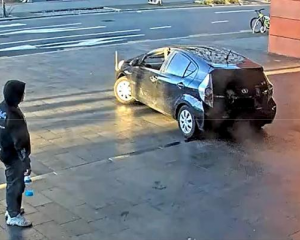By Sally Blundell of Frank Film
They took to the streets in their thousands.
On 5 April, high school students across the country mobilised in a nationwide call for climate justice, an ongoing ban on oil and gas exploration and a “fossil-free world”.
Not as many as the estimated 170,000 students that took to the streets in 2019, but with comparable noise and fervour.
A few weeks later, in the leafy environs of Christchurch’s Riccarton Bush, Climate Change Commission chair Rod Carr takes questions from three of the participants – Tinura Gajamange, Mikayla Molly and Marisa Reeg.
Are we a world leader in climate change and activism? asks Gajamange.
“Maybe in 2018 we were taking a leading position but it’s pretty clear now that we’re not. There’s 20 countries way ahead of us already in reducing their greenhouse gas emissions.”
Carr knows his audience – he served as vice-chancellor of the University of Canterbury from 2009 to 2019. He speaks clearly and emphatically.
He is quick to point out the role of the Commission, to advise the government of the steps required for New Zealand to reduce emissions and improve climate resilience, and to monitor progress towards that goal. Not advocacy, not activism, “but that doesn’t mean there isn't an essential role for advocacy and activism.”
Just days earlier the Commission released its fourth budget setting out the country's emissions cap for 2036-2040. The draft advice recommends a goal of just under 27 million tonnes of greenhouse gas a year, down from 73 million tonnes in 2021.
To do this, he explains, New Zealand will have to move away from burning liquid fuel to get around. This will require new infrastructure for low emission cars, making it “harder and more difficult” to bring in high emitting cars, and building more electric generation for wind and solar. This in turn will require the government to create “a degree of certainty so the private sector will make those investments.”
How’s the government going?
“It’s early days for the government. By the end of this year they have to have shown New Zealand an emission reduction plan that would be consistent with the budget which is already in place for 2026-2030.”
Molly asks what young people active in the climate space can do.
“One is exactly what you are doing – become informed, don’t let the rabbit holes of pseudoscience distract from the big issue – we have to stop the combustion of fossil fuels in the open air. Whether that’s to make milk powder, to drive cars, to heat homes. We’ve just got to stop.”
Secondly, “Talk to your peer group, talk to your parents, talk to your future employers.”
Thirdly, “Any time you buy something, the system is designed to put that thing back on the shelf. If you buy an internal combustion engine, the system will make another one. If you take a long haul flight to have a holiday in Fiji, the system will give you another plane to fly.
“So if you want things to change, make sure you, your family, your friends stop buying the bad stuff. And buy the good stuff.
And finally, “You get the people you vote for.”
Carr refutes the idea that New Zealand is too small to make a difference.
“Every tonne of greenhouse gas emissions matters, wherever it comes from.”
Irrespective of what China does, he says, if the country stops combusting fossil fuels for transport it will reduce health care costs by $2.7 billion a year by 2035, “because we’re the ones that breathe that crap”. If we move from fossil fuels to renewable sources of energy “our household energy bills will be $2 billion lower by 2035.”
Carr’s message to the young activists is upbeat. Out of a national car fleet of around 4.2 million, only about 100,000 are electric, low emissions or hybrids, but as prices come down, as batteries get lighter and hold more energy, “you're going to find these cars are cheaper to run and cheaper to buy.”
Within the dairy industry, there’s a wide variety between low-emitting herds that emit about 8 kilos of greenhouse gas per kilo of milk protein and high emitting herds that emit as much as 18 kilos of greenhouse gas per kilo. “We need to share the best practices, the best breeding, the best feeding regimes and in some cases choose not to use poor land that’s associated with high emitting herds.
“So I am very optimistic for New Zealand. New Zealand has significant opportunities to create a thriving low-emission, climate resilient future for this country.”













